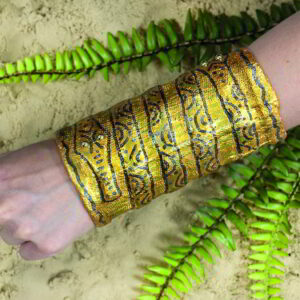Skill Level
Beginner
Time to Make
2 hours + drying time for air-hardening clay + paint
Adult Supervision Needed
Yes
How to Make
-
To make the background for the plaque, break off about half the clay from a block.
Wrap the remaining clay in the packaging then put it into a polythene bag so it doesn’t dry out. - Place the clay onto a plastic or wooden board, or use a sheet of polythene. Press the clay with your fingers to flatten it then roll it out into a rectangle with a rolling pin, roughly 18cm x 12cm. Trim the edges, or if you prefer leave them uneven for an aged effect.
- Lightly draw a simple shape for the crocodile in the clay surface with the end of a modelling tool, or use a pencil. Use the outline as a guide for building up the relief design.
-
To make the body, break off some more clay from the block then shape it into a 6cm diameter ball.
Press the clay with your fingers to elongate it and very roughly shape the head, body and tail. Press the clay onto the background. Smooth the clay with a modelling tool to define the crocodile shape. Work around the edges where the body joins the background. Add a small amount of water if the clay starts to dry out. - To make a leg, roll 2 short clay pieces then press them onto the background into a bent ‘V’ shape next to the body. Repeat to make 3 more legs in the same way. Use a modelling tool with some water to define the leg shapes, removing clay around the edges if they look too big. Press lines into the legs for the crocodile’s toes.
-
To make a bumpy texture on the crocodile, roll 3 thin clay strands then press them along the back, adding water if the clay feels too dry. Use a modelling tool to press along the clay strands at 1-2cm intervals to make a line of raised bumps.
Use a modelling tool to make a criss-cross lined texture on the crocodile’s body and legs. - Shape the crocodile’s eyes with a modelling tool, or use a pen lid to press semi-circles onto the head.Use a pencil or pointed tool to make nostrils and holes around the edge of the background.
- Leave the clay to dry for 24 hours on your work surface board or plastic sheet then carefully turn it over to dry out the back. If the clay still feels wet, leave it to dry propped on its side so it doesn’t bend. Leave for another 24 hours until the clay has fully dried before painting.
- Brush ochre poster paint over the clay with a darker brown or black around the edge of the crocodile. Leave to dry then add a second coat if necessary. Lightly brush the surface with bronze or gold metallic lustre paint. Leave to dry.
- Brush some clear varnish over the crocodile and background to seal the surface.



Top Tip
Look at examples of bronze art from the Kingdom of Benin as inspiration for making your crocodile design. Or, try making another African creature like a leopard, mudfish or python. Allow at least 48 hours for the clay to dry before painting it.
Tagged with:













